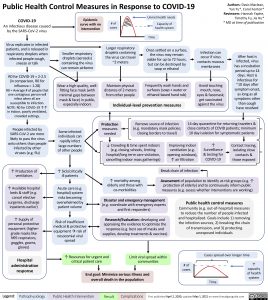Public Health Control Measures in Response to COVID-19
Authors: Davis Maclean, Yan Yu*, Carol Fenton* Reviewers: Hannah Yaphe, Timothy Fu, Jia Hu* * MD at time of publication
COVID-19
An infectious disease caused by the SARS-CoV-2 virus
Virus replicates in infected patients, and is released in respiratory droplets when infected people cough, sneeze or talk
R0 for COVID-19 = 2-2.5 (in comparison, R0 for influenza = 1.28)
R0 = Average # of people that one contagious person will infect when all are susceptible to infection. NOTE: R0 for COVID-19 ↑↑ in indoor, poorly ventilated, crowded settings.
People infected by SARS-CoV-2 are more likely to pass the virus onto others than people infected by other viruses (e.g. flu)
↑ Production of ventilators
↑ Available hospital beds & staff (e.g. cancel elective surgeries, discharge inpatients earlier)
↑ Supply of personal protective equipment (higher- grade masks like N95 respirators, goggles, gowns, gloves)
Hospital administration response
Epidemic curve with no intervention
Smaller respiratory droplets (aerosols) containing the virus can remain airborne
Wear a high-quality, well- fitting face mask (with minimal gaps between mask & face) in public, especially indoors
Some infected individuals can rapidly infect large numbers of other people
↑ Sick/critically ill patients
Acute care (e.g. hospital) system risks becoming overwhelmed by patient volume
Risk of insufficient medical & protective equipmentàrisk of nosocomial viral spread
# of cases
Larger respiratory droplets containing the virus can travel ~2 meters
Maintain physical distance of 2 meters from other people
Unmet health needs
Capacity of health system
Time
Once settled on a surface, the virus may remain viable for up to 72 hours, but can be destroyed by soap or ethanol
Frequently wash hands and surfaces (soap + water or ethanol-based hand rub)
Infection can
occur if virus contacts mucous membranes
Avoid touching mouth, nose, eyes & facemask; get vaccinated against the virus
After host is infected, virus has a incubation period up to 14 days. Host is infectious for ~10 days after symptom onset, as long as all symptoms other than cough have resolved
Individual-level prevention measures
Protection
measures needed
Remove source of infection (e.g. mandatory mask policies; closing borders to travel)
14 day quarantine for returning travelers & close contacts of COVID patients; minimum 10 day isolation for symptomatic patients
↓ Crowding & time spent indoors (e.g. closing schools, limiting hospital/long term care visitation, cancelling indoor mass gatherings)
↑ mortality among elderly and those with co-morbidities
Improving indoor ventilation (e.g. opening windows), ↑ air filtration
Break chain of infection
↑ Surveillance & testing for COVID-19
Contact tracing, isolating close contacts & those exposed
Assessment of population to identify at-risk groups (e.g. ↑ protection of elderly) and to continuously inform public measures (e.g. assess whether interventions are working)
Disaster and emergency management
(e.g. coordinate with emergency experts and first responders)
Research/Evaluation: developing and appraising the evidence to optimize the response (e.g. best use of masks and supplies, develop treatments & vaccines)
Public health control measures
Community (e.g. out-of-hospital) measures to reduce the number of people infected and hospitalized. Goals include 1) removing the infection sources, 2) breaking the chain of transmission, and 3) protecting unexposed individuals
↑ Resources for urgent and critical patient care
Limit viral spread within communities
Cases spread over longer time
# of cases
↑ capacity of health system
End goal: Minimize serious illness and overall death in the population
Time
Legend:
Pathophysiology
Public Health Intervention
Result
Complications
First published April 2, 2020; updated May 1, 2021 on www.thecalgaryguide.com
Foundations
Systems
Other Languages
Population Health Health Promotion & Screening Public Health Control Measures in Response to COVID-19 COVID-Public-Health-Control-Measures

